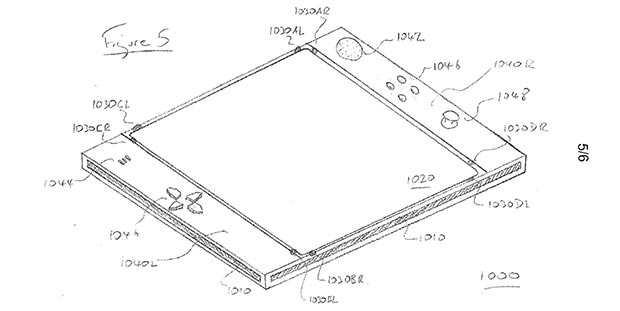In 2012 Sony filed a trademark for something called the “EyePad”. Whilst that name might have Apple squirming in their seats, it’s worth noting that it’s the technology here in question, not the name – besides, nobody at Sony is really that silly.
Anyway, the EyePad looks and feels like a regular tablet, but works in conjunction with cameras on either side of the controller which together generate 3D virtual buttons, which means it’ll function like any regular game controller if needed. It’s unlikely to be anything to do with the PlayStation 4 – the controller for that is most likely a regular looking Dual Shock with some minor adjustments (including a central touch pad and refined triggers) but it’s clear that Sony are still trying to do something a little out there as well as pushing next gen consoles.

The official description describes the EyePad thus:
“An input device for an entertainment device comprises a first main surface, one or more side edges, one or more motion sensors operable to generate motion data, and a wireless communicator for transmitting the motion data to the entertainment device, wherein an elongate illuminated region extends along some or all of one or more of the side edges.”
“In addition the input device may comprise a first stereoscopic camera and a second stereoscopic camera having respective viewpoints located at opposing corners of a first area of the main surface, the field of view of each stereoscopic camera encompassing a first volume of space immediately above the first area, wherein the first and second stereoscopic cameras are operable to generate respective stereoscopic images, from which a first depth map and complementary second depth map may be generated for opposite sides of an object placed within the first volume of space.”
Kooky.
Via Gamechup.




Peter Chapman
A gaming-focussed tablet?
Interesting, Sony’s Android mobile and tablet range seems to be getting more and more promising so, as something for the middle-distant future, this might be really cool.
Alex C
Sony’s what range? ;)
skibadee
Xperia Z looks really nice.
cam the man
Saw this earlier on N4G, thought it looks like a CD case and not very comfortable to hold/use for long periods.
quinkill
This is a patent filing not a design doc. The final product is likely to be much more ergonomic.
cam the man
I was thinking if it was designed like a tablet it wouldn’t be comfortable to use for long periods of play.
TSBonyman
3D virtual buttons? I feel nothing for them.
jeccross
Yeah, I don’t get it. Tablets suck for gaming as you can’t feel the buttons, not cos the on screen buttons dont look 3D enough.
igotmy9milli
New younger generations who will have grown up on touch screen devices have no need for buttons. You should see young kids playing FPS games and the like on touch screen devices.
Starman
At what point did all the gadget makers decide that normal buttons were bad?
ClubberLang
I don’t think the cameras would generate 3D buttons (no mention of any 3D capable screen). But instead capture a 3D image of whatever is above the “surface” I am assuming to render on a screen (like a tv or monitor)
There’s no mention that the “surface” is a display so perhaps a touch pad (like the back of the vita)
ClubberLang
Ooooo or it would map the area above the surface and allow a user to manipulate on screen 3D objects!
Bilbo_bobbins
was just about to reply to your comment above. This makes sense, quite clever too if it could be incorporated into games.
ClubberLang
It would, like playing tumble by using your hands to manipulate the blocks.
colmshan1990
Nope.
I just can’t figure out what exactly that patent means, or what the ‘Eyepad’ is doing with 3D buttons which aren’t actual buttons.
I’m confused.
ClubberLang
The more I read this the more I think the source got it a bit wrong. I don’t think it’s a tablet with 3D buttons but instead a control pad that allows you to interact with objects on screen by mapping out the 3D space above the pad and how you interact with it.
ClubberLang
Wow! I just read the patent and it looks like it’s going to be an AR marker (like a fancy wonderbook).
They specifically describe setting it on the ground and allowing eye pet to get on there and allowing the users hand to occupy a joint virtual space and interact with the eye pet.
I love technology! :-)
colmshan1990
That makes much more sense, although why do they have (virtual) buttons drawn on the diagram?
ClubberLang
I think they’re “actual buttons”. The patent even mentioned the trigger buttons having a place on the device.
Foxhound_Solid
Cool :-)